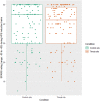The influence of a manipulation of threat on experimentally-induced secondary hyperalgesia
- PMID: 35757170
- PMCID: PMC9220919
- DOI: 10.7717/peerj.13512
The influence of a manipulation of threat on experimentally-induced secondary hyperalgesia
Abstract
Pain is thought to be influenced by the threat value of the particular context in which it occurs. However, the mechanisms by which a threat achieves this influence on pain are unclear. Here, we explore how threat influences experimentally-induced secondary hyperalgesia, which is thought to be a manifestation of central sensitization. We developed an experimental study to investigate the effect of a manipulation of threat on experimentally-induced secondary hyperalgesia in 26 healthy human adults (16 identifying as female; 10 as male). We induced secondary hyperalgesia at both forearms using high-frequency electrical stimulation. Prior to the induction, we used a previously successful method to manipulate threat of tissue damage at one forearm (threat site). The effect of the threat manipulation was determined by comparing participant-rated anxiety, perceived threat, and pain during the experimental induction of secondary hyperalgesia, between the threat and control sites. We hypothesized that the threat site would show greater secondary hyperalgesia (primary outcome) and greater surface area (secondary outcome) of induced secondary hyperalgesia than the control site. Despite a thorough piloting procedure to test the threat manipulation, our data showed no main effect of site on pain, anxiety, or threat ratings during high-frequency electrical stimulation. In the light of no difference in threat between sites, the primary and secondary hypotheses cannot be tested. We discuss reasons why we were unable to replicate the efficacy of this established threat manipulation in our sample, including: (1) competition between threats, (2) generalization of learned threat value, (3) safety cues, (4) trust, and requirements for participant safety, (5) sampling bias, (6) sample-specific habituation to threat, and (7) implausibility of (sham) skin examination and report. Better strategies to manipulate threat are required for further research on the mechanisms by which threat influences pain.
Keywords: Electrical stimulation; Healthy volunteers; Mechanical hyperalgesia; Pain; Secondary hyperalgesia; Threat.
© 2022 Bedwell et al.
Conflict of interest statement
Gillian J. Bedwell receives speakers’ fees for talks on pain and rehabilitation. Victoria J. Madden receives speakers’ fees for talks on pain and rehabilitation. Romy Parker receives speakers’ fees for talks on pain and rehabilitation, is a director of the not for profit organization Train Pain Academy, and serves as a councilor for the International Association for the Study of Pain. G. Lorimer Moseley has received support from: Reality Health, ConnectHealth UK, Seqirus, Kaiser Permanente, Workers’ Compensation Boards in Australia, Europe and North America, AIA Australia, the International Olympic Committee, Port Adelaide Football Club, Arsenal Football Club. Professional and scientific bodies have reimbursed him for travel costs related to presentation of research on pain at scientific conferences/symposia. He has received speaker fees for lectures on pain and rehabilitation. He receives book royalties from NOI group publications, Dancing Giraffe Press & OPTP for books on pain and rehabilitation. Caron Louw and Johan W. Vlaeyen have no conflicts of interest to declare. G. Lorimer Moseley is an Academic Editor for PeerJ.
Figures







References
-
- Auguie B. gridExtra: miscellaneous functions for graphics. R package version 2.3. 2017. https://CRAN.R-project.org/package=gridExtra https://CRAN.R-project.org/package=gridExtra
-
- Bates D, Maechler M, Bolker B, Walker S, Christensen HBR. lme4: Linear mixed-effects models using Eigen and S4. R package version 1.1-7. 2015. https://cran.r-project.org/web/packages/lme4/index.html https://cran.r-project.org/web/packages/lme4/index.html
Publication types
MeSH terms
Grants and funding
LinkOut - more resources
Full Text Sources
Medical

